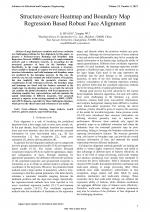| 2/2023 - 1 | View TOC | « Previous Article | Next Article » |
Structure-aware Heatmap and Boundary Map Regression Based Robust Face AlignmentHUANG, L. |
| Extra paper information in |
| Click to see author's profile in |
| Download PDF |
Author keywords
distance learning, image analysis, neural network, pattern analysis, supervised learning
References keywords
vision(46), face(32), alignment(26), recognition(25), pattern(23), facial(21), landmark(20), detection(18), cvpr(16), robust(11)
Blue keywords are present in both the references section and the paper title.
About this article
Date of Publication: 2023-05-31
Volume 23, Issue 2, Year 2023, On page(s): 3 - 10
ISSN: 1582-7445, e-ISSN: 1844-7600
Digital Object Identifier: 10.4316/AECE.2023.02001
Web of Science Accession Number: 001009953400001
SCOPUS ID: 85164342223
Abstract
Large head pose variations and severe occlusion are challenging problems for face alignment. In this paper, we propose a Structure-aware Heatmap and Boundary map Regression Network (SHBRN), consisting of a rough estimation network and a refinement network, to accounting for the structural geometry of faces via the boundary map. Specifically, in the rough estimation network, a structure-aware module is designed to capture low-level features rich in structure information, and both heatmaps and boundary maps are predicted by the hourglass network. In this way, the network can not only estimate the initial location of keypoints, but also implicitly take the geometric structure into consideration. In the refinement network, the boundary maps and heatmaps are fused with the features extracted in the rough stage via attention mechanism. As a result, the network can combine the global information with local appearance for obtaining complete face representations, and also optimize the spatial relationship of different keypoints. Our proposed network is superior to the existing methods on 300W, COFW, and AFLW datasets, especially for those challenging situations, which proves the effectiveness and robustness of our model. |
| References | | | Cited By |
Web of Science® Times Cited: 1 [View]
View record in Web of Science® [View]
View Related Records® [View]
Updated today
SCOPUS® Times Cited: 1
View record in SCOPUS® [Free preview]
View citations in SCOPUS® [Free preview]
[1] Biometric Identification Advances: Unimodal to Multimodal Fusion of Face, Palm, and Iris Features, KADHIM, O. N., ABDULAMEER, M. H., Advances in Electrical and Computer Engineering, ISSN 1582-7445, Issue 1, Volume 24, 2024.
Digital Object Identifier: 10.4316/AECE.2024.01010 [CrossRef] [Full text]
Disclaimer: All information displayed above was retrieved by using remote connections to respective databases. For the best user experience, we update all data by using background processes, and use caches in order to reduce the load on the servers we retrieve the information from. As we have no control on the availability of the database servers and sometimes the Internet connectivity may be affected, we do not guarantee the information is correct or complete. For the most accurate data, please always consult the database sites directly. Some external links require authentication or an institutional subscription.
Web of Science® is a registered trademark of Clarivate Analytics, Scopus® is a registered trademark of Elsevier B.V., other product names, company names, brand names, trademarks and logos are the property of their respective owners.
Faculty of Electrical Engineering and Computer Science
Stefan cel Mare University of Suceava, Romania
All rights reserved: Advances in Electrical and Computer Engineering is a registered trademark of the Stefan cel Mare University of Suceava. No part of this publication may be reproduced, stored in a retrieval system, photocopied, recorded or archived, without the written permission from the Editor. When authors submit their papers for publication, they agree that the copyright for their article be transferred to the Faculty of Electrical Engineering and Computer Science, Stefan cel Mare University of Suceava, Romania, if and only if the articles are accepted for publication. The copyright covers the exclusive rights to reproduce and distribute the article, including reprints and translations.
Permission for other use: The copyright owner's consent does not extend to copying for general distribution, for promotion, for creating new works, or for resale. Specific written permission must be obtained from the Editor for such copying. Direct linking to files hosted on this website is strictly prohibited.
Disclaimer: Whilst every effort is made by the publishers and editorial board to see that no inaccurate or misleading data, opinions or statements appear in this journal, they wish to make it clear that all information and opinions formulated in the articles, as well as linguistic accuracy, are the sole responsibility of the author.





